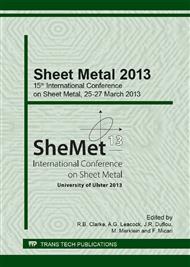p.92
p.100
p.108
p.117
p.125
p.133
p.141
p.149
p.156
Method to Emboss Holograms into the Surface of Sheet Metals
Abstract:
Holograms are industrially used as decorative design elements to increase the value of products. As they are hard to copy, holograms are also used for brand protection and product identification. The state-of-the-art is to emboss holograms in the surface of polymeric foils and to apply them to products by adhesive bonding. Examples are holograms on credit cards, banknotes or identification cards. In this paper, a new method to emboss holograms in the surface of sheet metals is presented. By this, parts made of sheet metal such as decorative interior parts of cars, battery housings or packaging of cosmetic products can be equipped with holograms during their production process. Hence, adhesive bonding and the required additional handling operations are not necessary. An embossing tool and the results of experimental hologram embossing are described. Aluminium Al99.9, aluminium-magnesium alloy AW-5505, copper and zinc-coated deep drawing steel DC05 were used as sheet metals to be embossed. Furthermore, a new method and a device to produce master holograms are presented. Master holograms are required to produce embossing dies with the hologram on its surface (referred to as shim). The device is based on a laser light source and a spatial light modulator (SLM). With help of the SLM, simultaneous transfer of 1920 x 1080 pixels of a Computer Generated Holograms (CGH) topography to a plate coated with photoresist is possible. Compared to todays industrial mastering of holograms which is done pixel by pixel, the time required for the process is much shorter. In addition, investment costs are lower compared to currently used electron-beam-lithography devices.
Info:
Periodical:
Pages:
125-132
Citation:
Online since:
April 2013
Keywords:
Price:
Сopyright:
© 2013 Trans Tech Publications Ltd. All Rights Reserved
Share:
Citation:


